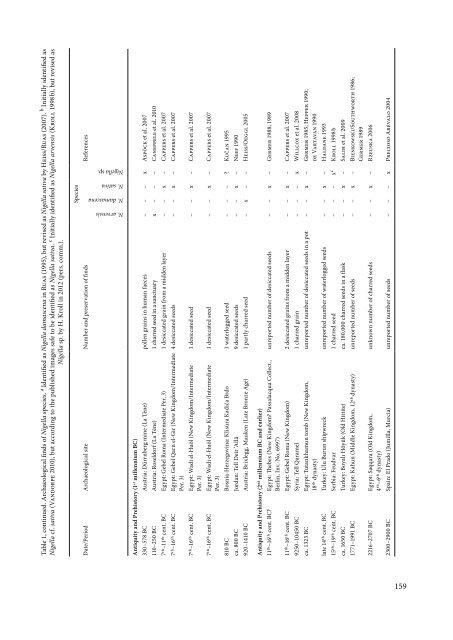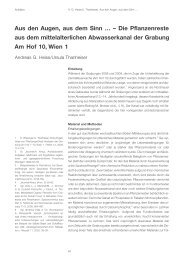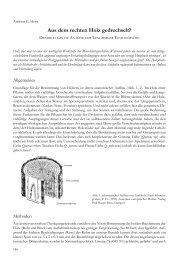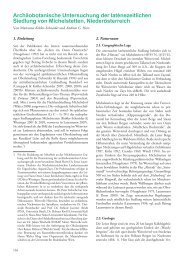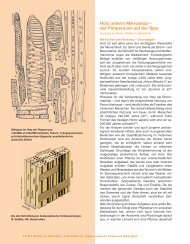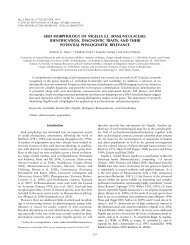View - erbsenzaehler.at
View - erbsenzaehler.at
View - erbsenzaehler.at
Create successful ePaper yourself
Turn your PDF publications into a flip-book with our unique Google optimized e-Paper software.
Table 1, continued. Archaeological finds of Nigella species. a Identified as Nigella damascena in Ruas (1995), but revised as Nigella s<strong>at</strong>iva by Heiss/Ruas (2007). b Initially identified as<br />
Nigella cf. s<strong>at</strong>iva (Vandorpe 2010), but according to the published images safe to be identified as Nigella s<strong>at</strong>iva. c Initially identified as Nigella arvensis (Kroll 1998 b), but revised as<br />
Nigella sp. by H. Kroll in 2012 (pers. comm.).<br />
Species<br />
D<strong>at</strong>e/Period Archaeological site Number and preserv<strong>at</strong>ion of finds<br />
References<br />
N. arvensis<br />
N. damascena<br />
N. s<strong>at</strong>iva<br />
Nigella sp.<br />
Antiquity and Prehistory (1st millennium BC)<br />
330–578 BC Austria: Dürrnberg mine (La Tène) pollen grains in human faeces – – – x Aspöck et al. 2007<br />
110–250 BC Austria: Roseldorf (La Tène) 1 charred seed in a sanctuary x – – – Caneppele et al. 2010<br />
7th–11th cent. BC Egypt: Gebel Roma (Intermedi<strong>at</strong>e Per. 3) 1 desicc<strong>at</strong>ed grain from a midden layer – – x – Cappers et al. 2007<br />
7th–16th cent. BC Egypt: Gebel Qarn el-Gir (New Kingdom/Intermedi<strong>at</strong>e 4 desicc<strong>at</strong>ed seeds – – x – Cappers et al. 2007<br />
Per. 3)<br />
7th–16th cent. BC Egypt: Wadi el-Huôl (New Kingdom/Intermedi<strong>at</strong>e 1 desicc<strong>at</strong>ed seed – – x – Cappers et al. 2007<br />
Per. 3)<br />
7th–16th cent. BC Egypt: Wadi el-Huôl (New Kingdom/Intermedi<strong>at</strong>e 1 desicc<strong>at</strong>ed seed – – x – Cappers et al. 2007<br />
Per. 3)<br />
810 BC Bosnia-Herzegovina: Klisura Kadića Brdo 1 w<strong>at</strong>erlogged seed – – – ? Kučan 1995<br />
ca. 800 BC Jordan: Tell Deir ‘Allā 9 desicc<strong>at</strong>ed seeds – – x – Neef 1990<br />
920–1410 BC Austria: Brixlegg, Mauken (L<strong>at</strong>e Bronze Age) 1 partly charred seed – x – – Heiss/Oeggl 2005<br />
Antiquity and Prehistory (2 nd millennium BC and earlier)<br />
11th–16th cent. BC? Egypt: Thebes (New Kingdom? Passalacqua Collect.,<br />
Berlin, Inv.-No. 6997)<br />
unreported number of desicc<strong>at</strong>ed seeds – – x – Germer 1988; 1989<br />
11th–16th cent. BC Egypt: Gebel Roma (New Kingdom) 2 desicc<strong>at</strong>ed grains from a midden layer – – x – Cappers et al. 2007<br />
9250–10450 BC Syria: Tell Qaramel 1 charred grain – – – x Willcox et al. 2008<br />
ca. 1323 BC Egypt: Tutankhamun tomb (New Kingdom,<br />
18th dynasty)<br />
unreported number of desicc<strong>at</strong>ed seeds in a pot – – x – Germer 1985; Hepper 1990;<br />
de Vartavan 1990<br />
l<strong>at</strong>e 14th cent. BC Turkey: Ulu Burun shipwreck unreported number of w<strong>at</strong>erlogged seeds – – x – Haldane 1993<br />
15th–19th cent. BC Serbia: Feudvar 1 charred seed – – – x c Kroll 1998 b<br />
ca. 1650 BC Turkey: Boyalı Höyük (Old Hittite) ca. 180,000 charred seeds in a flask – – x – Salih et al. 2009<br />
1771–1991 BC Egypt: Kahun (Middle Kingdom, 12th dynasty) unreported number of seeds – – x – Bienkowski/Southworth 1986;<br />
Germer 1989<br />
2216–2707 BC Egypt: Saqqara (Old Kingdom,<br />
4th–6th dynasty)<br />
unknown number of charred seeds – – x – Rzeuska 2006<br />
2300–2900 BC Spain: El Prado (Jumilla, Murcia) unreported number of seeds – – – x Precioso Arévalo 2004<br />
159


